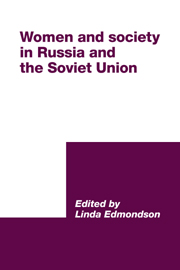Book contents
- Frontmatter
- Contents
- Notes on contributors
- Preface
- Introduction
- 1 ‘Better halves’? Representations of women in Russian urban popular entertainments, 1870-1910
- 2 The Silver Age: highpoint for women?
- 3 Women pharmacists in Russia before World War I: women's emancipation, feminism, professionalization, nationalism and class conflict
- 4 Women's rights, civil rights and the debate over citizenship in the 1905 Revolution
- 5 Laying the foundations of democracy in Russia: E. D. Kuskova's contribution, February–October 1917
- 6 Mariia L. Bochkareva and the Russian amazons of 1917
- 7 Russian women writers: an overview. Post-revolutionary dispersion and adjustment
- 8 Victim or villain? Prostitution in post-revolutionary Russia
- 9 Young women and perestroika
- 10 Glasnost and the woman question
- Index
Introduction
Published online by Cambridge University Press: 22 October 2009
- Frontmatter
- Contents
- Notes on contributors
- Preface
- Introduction
- 1 ‘Better halves’? Representations of women in Russian urban popular entertainments, 1870-1910
- 2 The Silver Age: highpoint for women?
- 3 Women pharmacists in Russia before World War I: women's emancipation, feminism, professionalization, nationalism and class conflict
- 4 Women's rights, civil rights and the debate over citizenship in the 1905 Revolution
- 5 Laying the foundations of democracy in Russia: E. D. Kuskova's contribution, February–October 1917
- 6 Mariia L. Bochkareva and the Russian amazons of 1917
- 7 Russian women writers: an overview. Post-revolutionary dispersion and adjustment
- 8 Victim or villain? Prostitution in post-revolutionary Russia
- 9 Young women and perestroika
- 10 Glasnost and the woman question
- Index
Summary
Over the past two decades, the study of women in Russian and Soviet society has become one of the liveliest areas of Western research into Russian literature, history and the social sciences. The spark that ignited this new enthusiasm was, for many, the women's movement in the West, which burst into life in the late 1960s after a long quiescence of almost fifty years. For some of those who became involved in Russian women's studies, this new wave of feminism affirmed what they already knew; for others it had the force of a revelation; for still others it produced confusion or ambivalence and only slowly prompted them to view the world – and academia – from a new perspective. But however the new ideas were received, there is no doubt that they were responsible for generating a widespread curiosity that had never previously existed in the West about the history of Russia's female population, about Russian women writers and artists and about the current social and economic situation of women in the Soviet Union.
During this twenty-year period, however, most of the Western scholars who pursued these new concerns were living with a paradox. Many were initially attracted to the study of Russian and Soviet women because it seemed (from a Western perspective) that a degree of equality and recognition had been won by women in the Soviet Union that had not been achieved in the West.
- Type
- Chapter
- Information
- Women and Society in Russia and the Soviet Union , pp. 1 - 4Publisher: Cambridge University PressPrint publication year: 1992

